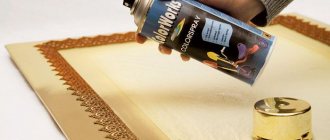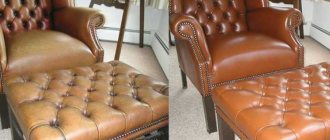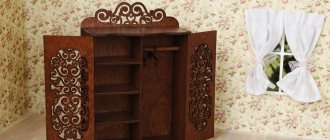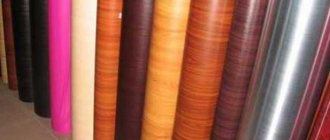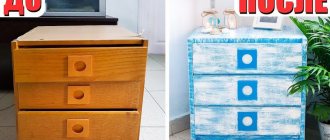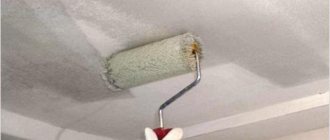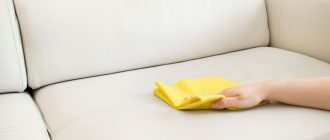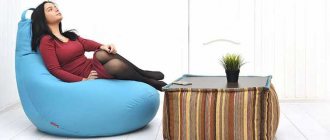What kind of furniture can be repainted?
Thanks to modern paint and varnish coatings, any furnishings and garden furniture can be updated:
- wooden;
- metal;
- plastic;
- from pressed sawdust;
- varnished;
- laminated.
You can repaint modern and Soviet furniture. The laminate and varnish are completely removed using a grinder with a circular attachment. It is enough to sand smooth surfaces to make them rough.
How to choose paint for furniture
Manufacturers offer a huge selection of paint. When painting old furniture, it is best to choose water-based compositions - acrylic or thixotropic. The first one is easy to dilute in water, it is quickly applied and dries. The second one does not drip; when it dries, it becomes like plastic and very dense.
On sale you can find options for painting garden furniture; it cannot be used for household items.
When choosing, take into account the style and characteristics of the item. If the task is to preserve the natural texture and natural color, then colorless compositions are chosen. They will protect surfaces from adverse external influences, only slightly changing its shade.
And if you need to paint without preliminary preparation of surfaces, it is better to stick with acrylic paint. Alkyd options will provide the best protection, while oil-based ones will help create a matte texture.
What you need for work
Approximate list of materials and tools:
| Inventory | Description |
| Dye | In cans or aerosols |
| Varnish | Glossy, matte or semi-matte |
| Putty, primer | Same base as paint |
| Sandpaper | Coarse and fine grain |
| Plastic bath | For paint |
| Paint brush | With synthetic bristles, for painting small parts |
| Roller | Short pile, for large surfaces |
| Small rubber spatula | For spreading putty |
| Screwdriver | For dismantling prefabricated objects - tables, sofas, cabinets |
| Masking tape | Paste over fixed fittings |
| Newspapers, plastic film | Place under the product |
You will also need gloves and safety glasses for work if the paints and varnishes emit a pungent odor.
Priming process
Many people wonder about the need for a primer, and we can say with full confidence that if you want to paint a cabinet or chest of drawers with high quality with your own hands, then you should definitely prime the surface. This is due to the fact that the primer will prevent the surface of the cabinet from absorbing moisture. This will promote better drying. Also, with a primer, you will not lose the color you want, since when applying paint to an unprimed surface, it does not matter whether it is chipboard or ordinary wood. During drying, the color changes slightly, as some of it will be absorbed into the material.
When it comes to the most suitable primer, it is best to use an acrylic-based primer. This is due to the fact that the components of such a primer will interact remarkably with the acrylic paint you choose.
Treating the surface with acrylic primer is quite simple. You should first read the instructions for using this material. An important point is to take into account the drying time of the soil. Before you paint your dresser or cabinet, you need to let the primer dry completely. It is also important to carry out clear calculations of the surface that you decide to treat. So, you can purchase the amount of material you need.
It is necessary to prime a chest of drawers or a cabinet using a roller, in a relatively thin layer. Then leave our chest of drawers or closet for a while to dry completely.
Before painting, the surface must be primed
Preparatory work
To ensure an even coating, the surface must be properly prepared for painting.
Visual inspection
Before work, assess the condition of the piece of furniture. Old chairs, sofas and armchairs often need to be reupholstered. Before painting, you also need to fix wobbly legs and squeaky doors.
Removing old coating
In addition to sandpaper and the sanding attachment of the grinder, varnish is removed from furniture using solvents or heated with a hair dryer, and then cleaned off. But the easiest way to roughen a smooth surface is by sanding it with sandpaper.
Sanding
Wooden furniture is sanded along the grain lines. For better adhesion, the metal surface is degreased with acetone, alcohol or white spirit.
Puttying and priming
Deep cracks, chips and scratches that could not be smoothed out with sandpaper are covered with putty. For durable coating, latex compounds are used that form elastic compounds. As a result, the paint will not crack due to temperature changes.
Expert opinion
Zakharova Irina Yurievna
Cleaning professional with 15 years of experience. Our best expert.
Ask a Question
For metal, an anti-corrosion primer is used, and for previously painted surfaces, deep penetration compounds are used.
Before applying the primer, areas with putty are sanded again. A surface coated with a water-based primer should not be wiped with a damp cloth before painting.
See also
Table for mixing colors of acrylic paints and a color palette for work
We fix minor defects without removing old varnish
There are several ways to restore polished furniture if there are minor defects:
- Dull color and minor stains can be removed using a product made from orange oils and intended for wood care. To ensure that the product is distributed evenly, it is applied using a spray bottle, after which you take a cotton cloth and rub the surface.
- To get rid of stains, use a retouching marker, wax, or denatured alcohol. At the first stage, the surface is degreased using a weak solution of dishwashing detergent. After the moisture has dried, apply alcohol to a cotton swab and wipe the stains. Deep scratches can be removed with a marker. To restore shine, apply wax to the surface and rub it with a rag.
- Irregularities formed by small scratches are cleaned using a manicure file.
- If the wood is swollen as a result of moisture, rub the swelling area with a mixture of olive oil and salt. Leave for 30 minutes. During this time, salt absorbs moisture, and olive oil makes the wood fibers elastic. When the mixture is dry, remove it, apply wax and polish.
- Chips are removed using wood putty. The material is applied to the chip and the surface adjacent to it. After drying, the coating area is sanded using fine-grain sandpaper.
To refresh the polish, you can use the following solutions:
- flax oil, turpentine, vinegar in proportions 2:2:1;
- turpentine, alcohol, 10% soap solution, drying oil, shellac, water in proportions 25:15:1:5:4:45.
Pay attention to: Painting a barbecue: features of the choice of paint and application technique.
How can I repaint it?
You can update the appearance of old furniture using coloring compounds, tinting primer or varnish.
Primer
To paint wooden furniture you will need a special primer. The coating ensures reliable adhesion of the paint to the surface and has antiseptic properties. Compositions of a similar shade and from the same manufacturer are best in contact with each other. Due to differences in binding components in primer and paint from different companies, the strength of the coating is reduced.
Advantages and disadvantages
if you want to change the color of the product again, the surface is already ready for use;
easy to apply;
no need to dilute.
does not hide surface defects;
not resistant to damage.
Water-based soil will not withstand wet cleaning.
Stains, varnishes, waxes
Types of varnishes that can be used for furniture:
- water;
- nitro varnish;
- shellac;
- polyurethane.
Advantages and disadvantages
Durable coating is resistant to damage.
compositions must be diluted with solvents;
unpleasant smell.
Nitro varnish lasts longer on wooden decorations. Shellac creates an ideal glossy surface. Tinting varnish will make light wood several shades darker. Wax protects the surface, adds shine and tint. Special tinting and transparent impregnations emphasize the structure of wood or imitate expensive species on wooden surfaces. The most durable is ship varnish.
But it cannot be used indoors or on furniture due to the toxic substances it contains, which continue to evaporate for many years after application.
Paints
The following compositions are suitable for painting old furniture:
- water-based acrylic - allow air to pass through, preventing the appearance of fungus, do not smell;
- alkyd - resistant to moisture, suitable for bathroom furniture;
- oil ones are the most durable.
Advantages and disadvantages
several layers hide small surface defects;
most formulations are safe for health;
various application methods - roller, brush, spray gun;
wide selection of colors;
white compositions can be colored in any shade.
color may change under natural and artificial light.
To highlight decorations, you can use spray paints in metallic shades.
When choosing white paint, you need to pay attention to its shade. It comes in warm and cold tones. Red, orange and yellow pigments are added to warm tones, and blue and green to cool tones. You should also consider lighting, as white tones look different in a dark and light room. For example, white with a purple tint appears pink.
Selection of paint and additional materials
Painting lacquered furniture should be done with high-quality materials intended for wood. To process metal products, you need to purchase paint for metal products.
Additional materials for painting furniture.
The material for painting must be durable and stable:
- to exposure to moisture and dirt;
- to wear and abrasion;
- to mechanical stress;
- to low temperatures;
- to chemicals.
The base, stripped of obsolete varnish, can be coated with any paint depending on the owner’s preferences. If desired, you can get a semi-matte, matte, glossy or completely transparent finish. To make furniture white, you will need translucent paint. If you choose a matte option, the products will look outdated.
Paints for working with wood that you can choose from:
- acrylic - a water-based solution designed for working with wood, plywood, MDF, veneer, laminate;
- varnish - it is used to renew old coatings;
- enamel with a metallic effect - this paint is used to cover fittings and is also applied to wood to get a new shade.
If the surface to be treated is located in rooms with high temperatures or interacts with hot objects, then you should choose a paint that has a fire-retardant effect. The wood is first coated with a primer.
In addition to paint, you need to purchase auxiliary tools and materials:
- brush, roller – for applying paints and varnishes;
- spray gun - for processing large areas;
- emery sheet or sander - for sanding;
- scraper or metal brush - to remove old varnish;
- construction hair dryer - will be needed if you plan to heat an outdated coating;
- primer, varnish, putty, detergent, antiseptic, varnish thinner, and, if necessary, insect repellent.
Choosing a wash
The remover is used to remove old varnish. The chemical composition of the remover softens the outdated varnish coating and allows it to be completely removed.
When choosing a remover, it is important to consider its concentration. The horizontal surface is treated with a liquid remover, the vertical surface is treated with a substance in the form of a paste or gel. To treat large areas, use the product in powder form.
Remover-gel for removing old varnish.
Washing technology
Work with the wash is carried out in the fresh air using personal protective equipment. The remover is evenly applied to the furniture surface using a brush. In areas with severe damage, work with special care.
After applying the product, the furniture must be wrapped in polyethylene and left for the remover to take effect. The instructions for the product should indicate how long to wait. After this, remove the film and remove the varnish layer with a non-sharp spatula.
Use water to remove varnish and remover residues. Further roughing with sandpaper is carried out after the surface has dried. Then take fine-grained sandpaper and sand until the roughness is eliminated.
Pay attention to: Painting chipboard furniture at home: tips for beginners.
Step-by-step instructions for repainting
Stages of work:
- wash the item with water and detergent;
- after drying, disassemble into separate elements, remove handles, take out drawers, unscrew legs;
- treat with fine-grained sandpaper to smooth out roughness and remove the old coating;
- cover large cracks with putty;
- stick masking tape on parts that do not need to be painted;
- coat with primer;
- apply paint;
- After the first layer has dried, apply the second, and then, if necessary, the third.
See also
Top 3 powder paint removers, best removal methods and tips
When the paint is completely dry, the furniture is varnished. Metal frames are also sanded, covered with a metal primer, and then painted.
Which paint to choose?
- Enamel based paints are known for being hard, durable, corrosion resistant and easy to clean.
- Latex-based paints are also easy to clean and look nice, but they don't hide damage and aren't durable.
- The oil paints we discussed above have a strong, unpleasant odor and are absorbed into the wood as they cure, making them extremely durable and easy to clean.
Varnishing
Apply 2-3 layers of varnish to the painted and cleaned surface. Each layer must dry for at least 40 minutes. For varnishing, brushes are used or a special tampon is made - cotton wool is dipped into the composition and wrapped in linen cloth. The coating is applied evenly, using blotting movements and in any direction.
Painting equipment
Tools are another important question that arises in anyone who decides to paint a chest of drawers or a cabinet with their own hands. What is the best way to paint a cabinet, with a brush or a roller? Of course, here you must take into account your preferences and skills, but we still recommend using a brush. This tool is more reliable and practical. Using a brush, you can apply paint in an even, uniform layer over the entire surface. Plus, the brush will be an excellent assistant in painting hard-to-reach places.
When you go to a hardware store, you can find a huge selection of different brushes and rollers. The choice of tools is as important as the selection of paint. You should buy only high-quality brushes and rollers. Otherwise, fluff may remain on the surface to be painted and fall out from a low-quality brush.
We recommend stocking up on brushes of different sizes, which will make your work easier.
How to paint antique
To artistically age a freshly painted surface, you will need candle wax and a knife.
How to create a vintage effect:
- clean the painted sides of the object from dust and sand;
- coat with a transparent primer;
- rub protruding parts, corners, edges with wax;
- cover with paint;
- after drying, scrape the waxed areas with a knife;
- smooth the surface with sandpaper.
Because of the wax, the paint does not adhere well to the surface and is easily removed, resulting in the effect of a coating worn away by time.
The second way to age wooden furniture:
- cover the cleaned surface with a thin layer of white paint;
- wait until the coating is half dry;
- wipe with a dry cloth.
Finally, coat the product with clear varnish.
How and with what to paint a wooden crib
All children love to be surrounded by bright, colorful, light and cheerful objects. Painting children's furniture in bright colors, applying cartoon characters, fairy-tale characters, flowers, patterns or cute animals to its surface will delight any child and add a good mood to everyday life. You can create a designer crib in just a few weekends.
Dyeing white
Oak, pine, birch and maple lend themselves well to repainting in a light tone.
Dyeing method:
- wipe the surface with a damp cloth to collect dust;
- remove old paint first with coarse sandpaper and then sand with fine-grained sandpaper;
- cover carved decorations, moldings, slats with paint of a more saturated shade - light beige, pale blue;
- Apply white paint in 2-3 layers to the entire object and dried parts.
Tint paint emphasizes the decor on furniture, otherwise it blends into a plain surface.
Wooden furniture can be lightened using bleaching paste. As a result, whitish marks characteristic of antiquity remain on the surface of the product. Porous species are suitable for bleaching - oak, ash. To do this you will need a metal brush.
How to lighten furniture:
- paint the surface, cleaned of dust and old coating, with colored paint in one layer;
- after drying, make furrows with a wire brush along the wood fibers;
- apply the paste.
Clean the dried coating from any remaining paste with a dry cloth and secure the result with a finishing coat of varnish.
Painting the crib
Regardless of whether a new crib is being painted or an old one is being repainted, the surface must be prepared for work. Before repainting the crib, the old paint must be removed. There are also modern paints and varnishes that can simply be applied over the previous coating. But if a regular composition is chosen, the surface should be treated to completely remove the remnants of the old material. Sanding is carried out using sandpaper, when the work is finished, remove the dust with a clean rag. This will help make the paint layer more even, it will lie cleaner, and the product will turn out very beautiful.
To work you will need a roller, sponge and brush. For smooth large surfaces, use a roller. A brush is convenient for painting the posts and rods of the crib. A sponge is suitable for small parts. You can purchase paint in an aerosol package and spray paint it, but this technique is only good for a smooth background. In addition, paint consumption increases.
During painting, you should try to ensure that drops of paint do not collect in inappropriate places. To do this, do not put a large amount of paint on a roller or brush at one time.
After painting, use a rag or sandpaper to go over all edges where paint may have accumulated, especially in the lower part of the crib.
If you plan to not only paint the bed, but also paint it, it is better to prime the surface after sanding. The primer can be oil-based, latex-based or water-based. An oil base will be more durable, but the smell may be strong.
Features of coloring different materials
Solid boards and particle boards are distinguished by their absorbency. Preparing surfaces for painting also differs.
MDF
How to paint fiberboard furniture:
- clean and degrease the surface;
- sand with coarse sandpaper;
- coat with acrylic primer, carefully filling the cavities.
See also
How to properly prepare and paint a ceiling with acrylic paints
To ensure a smooth surface, several layers of paint will be required.
Chipboard
Boards made from compressed shavings are painted in approximately the same way:
- clean the surface from dust and degrease;
- putty is applied;
- smooth with sandpaper.
Paint is applied on top or primer is additionally used.
The peculiarity of particle boards is their initially uneven surface. To level it and reduce paint consumption, the boards need to be puttied.
Natural wood
Wood fibers rise when in contact with aqueous compounds. Therefore, after cleaning, the boards are coated with a primer, and after drying, they are sanded with fine-grained sandpaper. Furniture made from natural wood does not need to be coated with thick paint. To preserve the texture, transparent tinting and stains are used. With their help, cheap pine can be given the appearance of expensive oak. Varnishing without painting will highlight the beauty of the natural color of the wood.
How to make a choice
Painting furniture yourself begins with choosing the right paint. And here the following points are important:
- Result: If you want the product to have a matte surface, then the coloring matter should be exactly like that. Usually they remake furniture in existing interiors. A universal solution is to paint it white, which fits organically into many styles.
- Eco-style. For lovers of natural interiors, it is better to leave the furniture in its original form, but protect it from destruction with varnish, wax or impregnation. It is recommended to use them on new furniture.
- More expensive is not always better. When deciding what paint to paint furniture with, you should not choose extremely expensive options, for example, varnish for parquet or yachts. This will not make the furniture stronger, but it will be incredibly difficult to remove it if you don’t like the result.
- Acrylic compounds. They are recommended to be used for furniture, despite the fact that there are cheaper options. And all because they have a water-dispersed base, but it is very resistant, which allows it to withstand up to 500 full washes without disturbing the appearance. This paint allows the furniture to “breathe”, which extends the life of the product. You can paint furniture with it without even removing household members from the room, because it is harmless.
- Savings. If you need to paint a large volume, but at the same time get a lasting result, then it is advisable to opt for alkyd enamels and paints. They take longer to dry, releasing harmful substances, so all work should be carried out in well-ventilated areas, but this is one of the most economical options.
- Wet rooms. Not all acrylic and dispersion compositions are suitable for them, so either choose moisture-resistant options or use alkyd ones, as they provide the necessary color durability.
- Oil, nitro paint. These substances are considered unsuitable for wood furniture and other wood products.
- Polyurethane and polyvinyl chloride. They are used by professionals, so it is better not to use them for amateur modifications. After all, their price is quite high, and it will be a pity for the money spent and the fact that the result differs from what was expected.
Types of varnishes suitable for MDF
Varnishing furniture made from MDF greatly increases its service life. The following varnishes are used:
- Alcohol or oil based. They dry quickly and are inexpensive, and oil-based ones give the surface additional moisture resistance.
- Alkyd-urea compositions of two components, which are mixed before starting work. Gives the surface strength and shine.
- Epoxy varnishes also consist of two components. They withstand contact with water well, so they are often used for application on countertops.
- Polyester compounds. Resistant to high temperatures and chemicals.
- Nitrocellulose. They are not durable, so they polish well.
- Acrylic-urethane and acrylic. They are diluted with water and do not have a strong odor. Surfaces coated with them are safe for health, allowing contact with food.
- Polyurethane. Used in places where increased wear resistance is required.
Please note: Leather painting
Applying varnish to furniture parts is a more complex process than painting.
